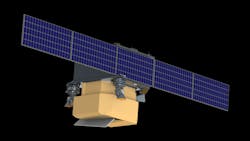General Atomics Completes EWS Review for Space Force
As the U.S. Space Force's (USSF) role in global defense grows in importance, defense contractors are accelerating their response times to fulfilling system requirements. Most recently, General Atomics Electromagnetic Systems (GA-EMS) has completed initial design review (IDR) of the space vehicle and ground segment of the USSF Space and Missile Systems Center (SMC) electro-optical infrared (EO/IR) weather system (EWS) satellite program. The program involves deploying a space vehicle (see the figure) that can meet military cloud characterization and theater imagery requirements in keeping with efforts to replace the aging Defense Meteorological Satellite Program (DMSP).
Scott Forney, president of GA-EMS, said: “GA-EMS is on track to deliver a prototype EWS system by 2022 capable of filling gaps in critical weather data for the U.S. military as the DSMP approaches the end of its lifecycle.” He added: Our low SWaP-C prototype is on the path to be the first satellite in a future constellation architecture that will provide better performance, resiliency, and mission assurance, as well as less than one-hour revisit time—ensuring timely and accurate weather forecast data for the warfighter and national security missions.”
As part of the fast response times to system development, GA-EMS has recruited capable partners, including EOVista, LLC, Atmospheric and Environmental Research Inc. (AER), and Parsons Corp. EOVista provides the EO/IR sensor payload, AER performs weather product generation, and Parsons is responsible for Enterprise Ground Station (EGS) command and control, and operations support. Nick Bucci, vice-president of Missile Defense and Space Systems at GA-EMS, explains: “The GA-EMS prototype employs an advanced small satellite design and an enhanced sensor with significant weather imaging upgrades that meet all current and future weather needs.” He adds: “The combination of low-cost sensor and satellite bus enables procurement of a disaggregated, global constellation that provides an organic, resilient, and timely global cloud-characterization capability and other weather products to U.S. warfighters.”
About the Author
Jack Browne
Technical Contributor
Jack Browne, Technical Contributor, has worked in technical publishing for over 30 years. He managed the content and production of three technical journals while at the American Institute of Physics, including Medical Physics and the Journal of Vacuum Science & Technology. He has been a Publisher and Editor for Penton Media, started the firm’s Wireless Symposium & Exhibition trade show in 1993, and currently serves as Technical Contributor for that company's Microwaves & RF magazine. Browne, who holds a BS in Mathematics from City College of New York and BA degrees in English and Philosophy from Fordham University, is a member of the IEEE.
